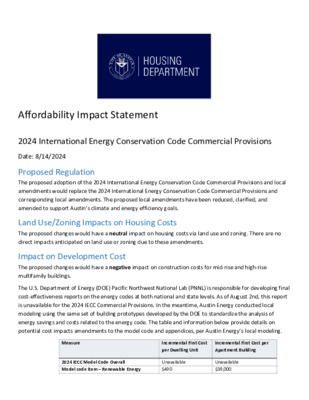Item 4: Energy Code 2 of 5 — original pdf
Backup

Affordability Impact Statement 2024 International Energy Conservation Code Commercial Provisions Date: 8/14/2024 Proposed Regulation The proposed adoption of the 2024 International Energy Conservation Code Commercial Provisions and local amendments would replace the 2024 International Energy Conservation Code Commercial Provisions and corresponding local amendments. The proposed local amendments have been reduced, clarified, and amended to support Austin’s climate and energy efficiency goals. Land Use/Zoning Impacts on Housing Costs The proposed changes would have a neutral impact on housing costs via land use and zoning. There are no direct impacts anticipated on land use or zoning due to these amendments. Impact on Development Cost The proposed changes would have a negative impact on construction costs for mid-rise and high-rise multifamily buildings. The U.S. Department of Energy (DOE) Pacific Northwest National Lab (PNNL) is responsible for developing final cost-effectiveness reports on the energy codes at both national and state levels. As of August 2nd, this report is unavailable for the 2024 IECC Commercial Provisions. In the meantime, Austin Energy conducted local modeling using the same set of building prototypes developed by the DOE to standardize the analysis of energy savings and costs related to the energy code. The table and information below provide details on potential cost impacts amendments to the model code and appendices, per Austin Energy’s local modeling. Measure Incremental First Cost per Dwelling Unit Incremental First Cost per Apartment Building 2024 IECC Model Code Overall Model code item – Renewable Energy Unavailable $490 Unavailable $39,000 Appendix CG – Electric Vehicle Charging Infrastructure Appendix CH – Space Hea�ng Electric-Ready Provisions Appendix CH – Water Hea�ng Electric-Ready Provisions Appendix CH – Cooking Electric-Ready Provisions Appendix CH – Clothes Drying Electric-Ready Provisions Appendix CI – Demand Responsive Controls Appendix CJ – Electrical Energy Storage System Total $360* $200 $200* $100 $0 $0 $385 $28,440* *If parking is provided $15,500 $15,800* *for individual water heating $7,900 $0 $0 $30,400 Over $1,735 Over $137,040 Source: Austin Energy • Model Code Item: Renewable Energy Systems: The 2024 IECC model code mandates that buildings include renewable energy systems, such as solar panels. However, exceptions exist for smaller projects or areas where installing solar panels isn’t feasible, like downtown Austin. For a typical 10-story, 79-unit apartment building, the required solar system would cost approximately $39,000, or $490 per unit. The payback period for this investment, considering current energy rates, would be around 22 years. • Model Code: Additional Efficiency Credits: The model code includes additional efficiency credits as prescriptive requirements within ASHRAE 90.1. Project teams can select from a variety of additional efficiency measures, with each credit representing roughly 0.1% energy cost savings. Multifamily projects in climate zone 2A must earn 50 credits, equivalent to a 5% energy cost savings. The U.S. Department of Energy (DOE) analyzed these additional credits and found them to be cost-effective. The flexibility in choosing credits allows for multiple design approaches to meet the requirements. • Appendix CG: Electric Vehicle Charging Infrastructure: The 2024 IECC includes provisions for Electric Vehicle (EV) Charging Infrastructure as an optional appendix, which is proposed for local adoption through an amendment to the code. The provisions require a certain percentage of parking spaces or dwelling units to be EV Ready and EV Capable. For multifamily buildings, 35% of parking spaces must be EV Capable, and 5% must be EV Ready. The cost to equip a building with this infrastructure varies based on the electrical capacity and circuit configuration. For a 79-unit high-rise apartment with 120 parking spaces, the estimated cost for EV infrastructure is $28,440. Retrofitting existing buildings to include EV infrastructure could cost 4-6 times more than incorporating it during construction. However, due to Austin’s recent elimination of parking requirements, EV readiness would only be required if the development chose to build parking. • Appendix CH – Electric-Ready Commercial Building Provisions: The 2024 IECC also includes Electric-Ready Commercial Building Provisions as an optional appendix, which is proposed for local adoption through an amendment to the code. The provisions require buildings that use combustion equipment for space heating, water heating, cooking, and clothes drying to be designed with the necessary electrical infrastructure for future electric equipment installations. The cost analysis references studies from California, which suggest that the incremental cost of making a high-rise apartment electric-ready is about $200 per unit for space heating and water heating. • Appendix CI – Demand Responsive Controls: Since Demand Responsive Controls are already required under the existing energy code, there is no additional cost associated with this measure. • Appendix CJ – Electrical Energy Storage System: The 2024 IECC includes provisions for Electrical Energy Storage Systems (ESS) as an optional appendix. The proposed provisions require either the installation of an ESS or the necessary infrastructure to support a future ESS. The estimated cost to install an ESS for a high-rise apartment building is approximately $30,400, or $385 per unit. Austin Energy's Green Building (AEGB) Evaluation and Development team created energy models for mid- rise and high-rise multifamily buildings under the Commercial IECC. The models estimate energy use and cost savings from adopting the 2024 IECC with local amendments. The appendices proposed for local adoption do not result in additional energy cost savings. However, the estimated annual energy cost savings for a mid-rise multifamily building is over $4,800 ($120 per unit), and for a high-rise building, it's over $9,200 ($115 per unit). Including solar production increases these savings to $6,500 ($165 per unit) and $11,000 ($140 per unit), respectively. Impact on Affordable Housing The proposed changes would have a negative impact on construction costs for mid-rise and high-rise multifamily buildings with income-restricted units. The proposed changes may increase the costs to build affordable multifamily housing, particularly if parking is provided, however these costs could be offset over the long-term through energy savings. Other Policy Considerations The proposed energy efficiencies contribute to Austin's goal of net-zero community-wide greenhouse gas emissions by 2040 from the Austin Climate Equity Plan. Manager’s Signature ___ ___________________________________